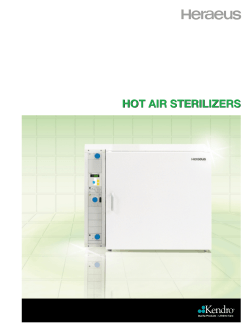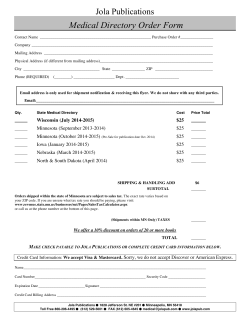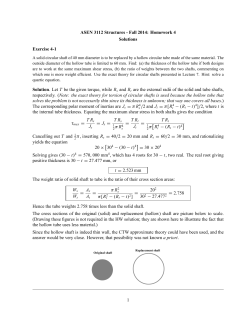
1. Stress Analysis Moment of Inertias
1. Stress Analysis Moment of Inertias 1. Atalet moment of inertia; 2 Ix = y dA 2. Polar moment of inertia; 2 2 Iy = x dA 2 Jz = (x + y )dA Shape Ix Iy Rectangle 3 bh /12 3 hb /12 Triangle bh3/36 hb3/36 Circle πd4/64 πd4/64 J bh 2 2 b +h 12 h2 +b2 18 bh πd4/32 Stresses Normal Stresses Tensile σ= Compression σ= F A Axial σb = Bending σb = Shear Stresses Tr = J Torsional F 3 = 16T/πd for solid circular beam VQ Q=Ay , Ib max = 4V/3A for A Mc I 32M 3 πd for solid circular beam solid circular beam Transverse (Flexural) max = 2V/A for hollow circular section max = 3V/2A for rectangular beam 2 Principle stresses σ1,2 σx + σy - σx - σy 2 = + + xy 2 2 2 Max. and min. shear stresses 1,2 - σ -σ x y 2 =+ + xy 2 tan2φ = 2 xy σx - σy 2 2 2 2 or σ' = σ x + 3 xy (for biaxial) σ' = σ1 - σ1σ 2 + σ 2 Von-Mises stresses Stresses States ε1 = ε2 = Triaxial stress state ε2 = σ1 E σ2 E σ3 E -μ σ2 + σ3 -μ -μ E σ1 + σ 3 E σ1 + σ 2 E Stress in Cylinders Thick-Walled (t/r>1/20) Wessels (internally and externally pressurized cyclinders): 2 σl = 2 2 2 pia - pob - a b (po - pi )/r σt = 2 b -a pi a 2 2 2 2 σr = 2 2 2 pia - pob + a b (po - pi )/r 2 b -a 2 2 2 b -a 2 If the external pressure is zero (po=0); b2 1+ 2 2 2 b -a r 2 σt = σr = a pi At the outer surface; At the inner surface; r=a σ r = -pi σ t = pi b2 1- 2 2 2 b -a r 2 a pi 2 2 2 2 b +a b -a r=b σ r = 0 σ t = pi 2a 2 2 b -a If the internal pressure is zero (pi=0); σ t = -po a2 1+ 2 2 2 b -a r b 2 σ r = -po a2 1- 2 2 2 b -a r b 2 2 At the outer surface; At the inner surface; 2b r=a σ r = 0 σ t = -po 2 2 b -a r=b σ r = -po σ t = -po 2 a=inside radius of the cylinder b=outside radius of the cylinder pressure po=external pressure Thin-Walled Wessels(t/r<1/20): σt = pdi σl = 2t pdi 4t Curved Members In Flexure: r= A dA σ= My Ae(r - y) σo = Mc o Aero , σi = Mc i Aeri ρ Press and Shrink Fit: σ it = -p o = 2 2 2 2 b +a b -a 2 2 2 2 c +b c -b + μo 2 2 Eo c - b i = - bp c + b σ ot = -p 2 2 bp b + a - μi 2 2 Ei b - a 2 2 bp c + b bp b 2 + a2 = o - i = 2 2 + μo + 2 2 - μi Eo c - b Ei b - a 2 2 c 2 - b2 b 2 - a 2 if Eo = Ei = E; interface pressure = p = b 2b 2 c 2 - a 2 E 2 2 2 2 b +a b -a pi=internal 2. Deflection Analysis k= k= F y , k=spring constant k= T θ = GJ l , k=Torsional spring rate AE for tension or compression loading l Castigliano’s Theorem: y= θ= U F Tl GJ U Total energy F Force on the deflection point θ Angular deflection Strain Energy 2 Axial Load U= Torsional Load U= F L 2AE 2 Direct Shear Force U= 2 Flexural Shear U= T L 2GJ CF 2AG 2 Bending Moment 2 2GA F L U= M 2EI dx C=1.2 for rectangular shape C=1.11 Circular C=2.0 for thin walled tubular, dx , C is constant Buckling Consideration: l Slenderness ratio= , k 1/2 k= l 2πEC = k 1 S y I A Euler column 2 Pcr Cπ E l l = Critical Unit Load = 2 A k k 1 l/k Johnson's Column or Pcr = Cπ2EI l2 Pcr l l < Critital Unit Load = A k k 1 2 Sy 1 l = Sy - 2π CE k 1. Both ends are rounded-simply supported 2. Both ends are fixed 2 C=1 C=4 3. One end fixed, one end rounded and guided 4. One end fixed, one end free C=2 C=1/4 3.Design For Static Strength Ductile Materials 1. Max. Normal Stress Theory (MNST): 3. Distortion Energy Theory If, σ1 > σ 2 > σ 3 σ' = For biaxial stress state; If, σ1 > σ 2 > σ 3 2 n= Sy σ1 2. Max. Shear Stress Theory (MSST): Yield strength (Ssy)=Sy/2 max = σ1 - σ 3 2 for biaxial stress state; max = n= 1 2 S sy τ max 2 2 σ x + 4τ xy in 2 2 σ' = σ x + 3τ xy shear n= 2 (σ1 - σ 2 ) + (σ 2 - σ 3 ) + (σ 3 - σ1 ) Sy σ' 2 2 Brittle Materials 1. Max. Normal Stress Theory (MNST): n= or n= If, σ1 > σ 2 > σ 3 Sut 3. The Modified Mohr Theory (MMT) If, σ1 > σ 2 > σ 3 S3 = σ1 Suc σ3 Suc Suc - Sut σ1 Sut 2. The Column Mohr Theory (CMT) or Internal Friction Theory (IFT): S3 = Suc Suc σ1 Sut σ 3 -1 n= S3 σ3 n= σ3 S3 σ3 5. Design for Fatigue Strength Endurance limit for test specimen (Se’); For ductile materials: Se’=0.5 Sut if Sut<1400 MPa Se’=700 MPa if Sut 1400 MPa For irons: Se’=0.4 Sut if Sut<400 MPa Se’=160 MPa if Sut 400 MPa For Aliminiums: Se’=0.4 Sut if Sut<330 MPa Se’=130 MPa if Sut 330 MPa For copper alloys: Se’ 0.4 Sut if Sut<280 MPa Se’ 100 MPa if Sut 280 MPa Se = ka kb kc kd ke Se’ Sf=10c Nb -1 0.8Su b = - log 3 Se 1 0.8Su 2 c = log Se ka : surface factor, ka=aSutb Surface Finish Factor a Factor b Ground 1.58 -0.065 Machined or Cold Drawn 4.51 -0.265 Hot Rolled 57.7 -0.718 As Forged 272 -0.995 kb : size factor; kb=1 if d 8 mm and kb= 1.189d-0.097 if 8 mm<d 250 mm bending & torsional loading. For non-rotating element, k b = 1.189deq -0.097 for deq=0.37d and Se’=0.45Sut For pure axial loading, kb=1 For combined loading, =1.11 if Sut 1520 MPa and =1 if Sut 1520 MPa for ductile materials. kc : reliability factor kd : temperature effects, kd=1 if T 3500 and kd=0.5 if 3500<T 5000 ke : stress concentration factor, ke=1/Kf Kf=1+q(Kt-1) Kt : geometric stress concentration factor, q=notch sensitivity. Modified Goodman Infinite Life n= 1 σa Se + σm Su Fa=(Fmax-Fmin)/2 Soderberg Finite Life n= 1 σ a σm + S f Su Infinite Life n= 1 σa Se Fm=(Fmax+Fmin)/2 + σm Sy Finite Life n= 1 σa Sf + σm Sy 6. Tolerances and Fits Clearance fit: TF=Cmax-Cmin Cmax=DU-dL Cmin=DL-dU Cmax=DU-dL Imax=dU-DL Imax=dU-DL Imin=dL-Du Transition fit: TF=Imax+Cmax Interference fit: TF=Imax-Imin Tolerances on the shaft, on the hole and on the fit TS=dU-dL TH=DU-DL TF=TH+TS 7. Design of Power Screws TR = Fdm L + πdmμ 2 πdm - μL TL = Fdm πdmμ - L 2 πdm + μL Considering μ = tanρ ; TR = Fdm tan λ + ρ 2 If μ tanλ or L πdm or TL = Fdm 2 tan ρ - λ or TL>0, then screw is self locking. If the friction between the stationary member and the collar of the screw is taken into consideration; TR = Fdm 2 tan λ + ρ + μc dc F TL = 2 Fdm 2 tan ρ - λ + μc dc F 2 Condition for self locking is : TL>0 Efficiency of screws: ε = obtain as, ε = tanλ tan λ + ρ To TR = FL 2πTR when collar friction is negligible, we Thread Stresses: Bearing Stresses σb = 4pF 2 πh d - dr 2 or σb = Fp πdm th s = 2F n = πdr h 6F πdmNp πdh N=h/p Tensile or Compressive stresses σx = F At = At πdt 2 dt = 4 Shear Stresses xy = 2F Bending Stresses Stresses on the body of screw: 2 For Nut Thread The maximum bending stress, σ = p Shear Stresses For Screw Thread where t = 16TR πdt 3 Combined stresses: Based on distortion energy theory; 2 σ' = σ x + 3 xy 2 n= Sy σ' Based on maximum shear stress theory; max = 1 2 2 σ x + 4 xy 2 n= S sy max dr + dm 2 8. Design of Bolted Joints Feb and Fep are forces shared by the bolt and by the members respectively. Fe=Feb+Fep Feb=CFe Fb=Fi+CFe Fm=Fi-(1-C)Fe Stiffness of bolt: k b = A bE b L Fep=(1-C)Fe stiffness ratio: Stiffness of members: 1 km = 1 k1 + C= 1 k2 Shigley and Mishke approach; 0 For cone angle of = 30 , ki = 1.813Ei d 1 1.15Li + 0.5d 1.15Li + 2.5d km ln 5 = 1 k1 + 1 k2 + .......... + 1 kn 1.813Ed If L1=L2=L/2 and materials are same, k m = 2.885L + 2.5d 0.577L + 2.5d 2ln 0 For cone angle of = 45 , ki = πEi d 5 2Li + 0.5d 2Li + 2.5d ln If L1=L2=L/2 and materials are same, k m = πEd L + 0.5d L + 2.5d 2ln 5 Wileman approach; kb kb km + .......... + 1 kn k m = EdA i e (Bid/L) where Ai and Bi are constants related to the material. For Steel Ai=0.78715 and Bi=0.62873, for Aliminium Ai=0.79670 and Bi=0.63816, for Gray cast iron Ai=0.77871 and Bi=0.61616. Filiz approach; km = π 2 Eeqd π d -B1 L 1 1- B 2 e 5 0.1d L where E eq = 2 B1 = L1 L2 B1 = 1- E1E 2 E1 + E2 8 Static loading; S Fb S y A t or Fb Sp A t 1- C nFe Fi Sp A t - CnFe Critical load= Fce = p = 0.85S y Fm 0 n=load factor of safety Fi 1- C Dynamic Loading: σa = CnFe 2A t σm = Fi At + σa ns = 1 σa Se Fi = A t Su CnFe Su +1 ns 2 Se + σm Su where: ns is strength factor of safety. Fi=the maximum value of preload for there is no fatigue failure. Constraints: 0.6Fp Fi 0.9Fp Fi max = A t Sut - where cFen Sut +1 2N Se Fp = A t Sp Fe (1- c) 3.5d c b 10d N Fi A t Sp - cFe N 9. Design of Riveted Joints Shearing of Rivets: = F , A Secondary Shear Force: F=Force on each rivet F'' i = Mri N ri 2 1 A= πd 2 4 Bearing (compression) Failure: =- F A , A=td, t=thickness of the plate = F A , A = w - Nd t w=width of plate Primary Shear Force: F' = Plate Tension Failure: N=number of rivets on the selected cross section F N Ai 1 10. Primary Shear Stress ' = Design of Welded Joints J = 0.707hJu I = 0.707hIu F A Secondary Shear Stress '' = Mr J Bending Stress σ= Mc I Table 9-3 Minimum weld-metal properties AWS electrode Number E60xx E70xx E80xx E90xx E100xx E120xx Tensile Strength Yield Strength Percent MPa 340 390 460 530 600 740 Elongation 17-25 22 19 14-17 13-16 14 420 480 530 620 690 830 Table 9-5 Fatigue-strength reduction factors Type of Weld Kf Reinforced butt weld Toe of transverse fillet weld End of parallel fillet weld T-butt joint with sharp corners 1.2 1.5 2.7 2.0 Table 9-1 Torsional Properties of Fillet Welds* Weld Throat Area Location of G Unit Polar Moment of Inertia *G is centroid of weld group; h is weld size; plane of torque couple is in the plane of the paper; all welds are of the same size. Table 9-2 Bending Properties of Fillet Welds* Weld Throat Area Location of G Unit Moment of Inertia *Iu, unit moment of inertia, is taken about a horizontal axis through G, the centroid of the weld group; h is weld size; the plane of the bending couple is normal to the paper; all welds are of the same size
© Copyright 2025












